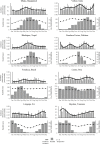Epidemiology of Shigella infections and diarrhea in the first two years of life using culture-independent diagnostics in 8 low-resource settings
- PMID: 32804926
- PMCID: PMC7451981
- DOI: 10.1371/journal.pntd.0008536
Epidemiology of Shigella infections and diarrhea in the first two years of life using culture-independent diagnostics in 8 low-resource settings
Abstract
Culture-independent diagnostics have revealed a larger burden of Shigella among children in low-resource settings than previously recognized. We further characterized the epidemiology of Shigella in the first two years of life in a multisite birth cohort. We tested 41,405 diarrheal and monthly non-diarrheal stools from 1,715 children for Shigella by quantitative PCR. To assess risk factors, clinical factors related to age and culture positivity, and associations with inflammatory biomarkers, we used log-binomial regression with generalized estimating equations. The prevalence of Shigella varied from 4.9%-17.8% in non-diarrheal stools across sites, and the incidence of Shigella-attributable diarrhea was 31.8 cases (95% CI: 29.6, 34.2) per 100 child-years. The sensitivity of culture compared to qPCR was 6.6% and increased to 27.8% in Shigella-attributable dysentery. Shigella diarrhea episodes were more likely to be severe and less likely to be culture positive in younger children. Older age (RR: 1.75, 95% CI: 1.70, 1.81 per 6-month increase in age), unimproved sanitation (RR: 1.15, 95% CI: 1.03, 1.29), low maternal education (<10 years, RR: 1.14, 95% CI: 1.03, 1.26), initiating complementary foods before 3 months (RR: 1.10, 95% CI: 1.01, 1.20), and malnutrition (RR: 0.91, 95% CI: 0.88, 0.95 per unit increase in weight-for-age z-score) were risk factors for Shigella. There was a linear dose-response between Shigella quantity and myeloperoxidase concentrations. The burden of Shigella varied widely across sites, but uniformly increased through the second year of life and was associated with intestinal inflammation. Culture missed most clinically relevant cases of severe diarrhea and dysentery.
Conflict of interest statement
The authors have declared that no competing interests exist.
Figures


Similar articles
-
The other Campylobacters: Not innocent bystanders in endemic diarrhea and dysentery in children in low-income settings.PLoS Negl Trop Dis. 2018 Feb 7;12(2):e0006200. doi: 10.1371/journal.pntd.0006200. eCollection 2018 Feb. PLoS Negl Trop Dis. 2018. PMID: 29415075 Free PMC article.
-
Quantitative PCR for detection of Shigella improves ascertainment of Shigella burden in children with moderate-to-severe diarrhea in low-income countries.J Clin Microbiol. 2013 Jun;51(6):1740-6. doi: 10.1128/JCM.02713-12. Epub 2013 Mar 27. J Clin Microbiol. 2013. PMID: 23536399 Free PMC article.
-
Use of quantitative molecular diagnostic methods to assess the aetiology, burden, and clinical characteristics of diarrhoea in children in low-resource settings: a reanalysis of the MAL-ED cohort study.Lancet Glob Health. 2018 Dec;6(12):e1309-e1318. doi: 10.1016/S2214-109X(18)30349-8. Epub 2018 Oct 1. Lancet Glob Health. 2018. PMID: 30287127 Free PMC article.
-
Global burden of diarrheal diseases among children in developing countries: Incidence, etiology, and insights from new molecular diagnostic techniques.Vaccine. 2017 Dec 14;35(49 Pt A):6783-6789. doi: 10.1016/j.vaccine.2017.07.036. Epub 2017 Jul 29. Vaccine. 2017. PMID: 28765005 Review.
-
Intestinal manifestations of invasive diarrheas and their diagnosis.Rev Infect Dis. 1991 Mar-Apr;13 Suppl 4:S311-3. doi: 10.1093/clinids/13.supplement_4.s311. Rev Infect Dis. 1991. PMID: 2047655 Review.
Cited by
-
Occurrence of Diarrheagenic Pathogens and Their Coinfection Profiles in Diarrheic Under Five Children and Tracked Human Contacts in Urban and Rural Settings of Eastern Ethiopia.Microbiol Insights. 2023 Sep 19;16:11786361231196527. doi: 10.1177/11786361231196527. eCollection 2023. Microbiol Insights. 2023. PMID: 37736061 Free PMC article.
-
Combating Childhood Infections in LMICs: evaluating the contribution of Big Data Big data, biomarkers and proteomics: informing childhood diarrhoeal disease management in Low- and Middle-Income Countries.EBioMedicine. 2021 Nov;73:103668. doi: 10.1016/j.ebiom.2021.103668. Epub 2021 Nov 3. EBioMedicine. 2021. PMID: 34742129 Free PMC article.
-
Shigella-Controlled Human Infection Models: Current and Future Perspectives.Curr Top Microbiol Immunol. 2024;445:257-313. doi: 10.1007/82_2021_248. Curr Top Microbiol Immunol. 2024. PMID: 35616717 Free PMC article. Review.
-
Frequency of bystander exposure to antibiotics for enteropathogenic bacteria among young children in low-resource settings.Proc Natl Acad Sci U S A. 2022 Sep 6;119(36):e2208972119. doi: 10.1073/pnas.2208972119. Epub 2022 Aug 29. Proc Natl Acad Sci U S A. 2022. PMID: 36037372 Free PMC article.
-
A Shigella flexneri 2a synthetic glycan-based vaccine induces a long-lasting immune response in adults.NPJ Vaccines. 2023 Mar 10;8(1):35. doi: 10.1038/s41541-023-00624-y. NPJ Vaccines. 2023. PMID: 36894570 Free PMC article.
References
-
- Platts-Mills JA, Liu J, Rogawski ET, Kabir F, Lertsethtakarn P, Siguas M, et al. Use of quantitative molecular diagnostic methods to assess the aetiology, burden, and clinical characteristics of diarrhoea in children in low-resource settings: a reanalysis of the MAL-ED cohort study. Lancet Glob Health. 2018;6: e1309–e1318. 10.1016/S2214-109X(18)30349-8 - DOI - PMC - PubMed
Publication types
MeSH terms
Grants and funding
LinkOut - more resources
Full Text Sources
Medical
Research Materials

